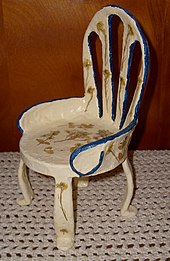Oshibana (押し花) is the art of using pressed flowers and other botanical materials to create an entire picture from these natural elements.[1] Such pressed flower art consists of drying flower petals and leaves in a flower press to flatten them, exclude light and press out moisture. These elements are then used to "paint" an artistic composition. The origin of this art form has been traced to 16th century Japan, but it is now practiced worldwide. The resulting artwork is referred to as an oshibana.[2]


Historical background
editAs early as the 16th century, samurai were said to have created oshibana as one of their disciplines to promote patience, harmony with nature and powers of concentration.[citation needed] Similarly, as botanists in Europe began systematic collection and preservation of specimens, art forms with the pressed plant materials developed, particularly during the Victorian era.[citation needed]
The art form became popular in the Holy Land in the late 1890s and into the 20th century when elaborate souvenir books combining photographs of the holy sites and the pressed flowers gathered at these sites. These photographs and pressed, dried flowers were artistically formatted and bound between olive wood covers to be sold to visitors.[3] American actress Grace Kelly, during her years as Princess Grace of Monaco, practiced oshibana and helped promote the art of pressed flowers worldwide, employing pressed botanical materials sent to her from abroad. My Book of Flowers, published in 1980, includes chapters on her art.[4][5]
Outside of Asia
editOutside of Asia, the art gained popularity in Britain during the Victorian era and experienced a revival from the 1970s to the early 2000s. Some artists outside of Asia have continued to use it.[6]
Pressing flowers makes them appear flat, and there is often a change in color, ranging from faded colors to a greater intensity of vibrant colors. The pressed flowers and leaves can be used in a variety of craft projects. They are often mounted on special paper, such as handmade paper, Ingres paper, Japanese paper, or paper decorated by marbling. Each leaf and flower is glued onto a precise location. With a creative approach to the use of materials, a leaf becomes a tree and petals form mountains.[citation needed]
Washes of watercolor painting are sometimes applied to the backing paper before the pressed material is attached. Pressed material may also be mounted on fabrics, such as velvet, silk, linen or cotton.[7]
Petals and leaves can be applied to wood furnishings using the technique of decoupage.[8]
Emerging methods
editOshibana artists are employing various new technologies in pressing methods, framing techniques and color enhancing to help the pressed materials keep their beauty through the years. Nobuo Sugino, pioneering figure in contemporary oshibana, and his father used dessicant papers to press flowers, helping hold color.[9] A method of vacuum-sealing frames to lock in color, texture and clarity of the petals and leaves and help prevent moisture and fungi intrusion was also developed in Japan and is now practiced by many oshibana artists worldwide.[10]
International organizations
editInternational Pressed Flower Art Society
editThe IPFAS in an international pressed flower organization that promotes pressed flower art and offers education and holds competitions. It has members from over 20 nations (as of 2010[update]) including Japan, the United Kingdom, United States, France, Germany, Mexico, and Australia. It was founded in 1999 by Nobuo Sugino, a Japanese pressed flower artist and President of Japan Wonderful Oshibana Club.[6]
Pressed Flower Craft Guild
editIn the UK, the Pressed Flower Craft Guild was established in 1983 by Joyce Fenton (a pressed flower artist) and Bill Edwardes (who devised the method of framing pressed flower pictures adopted by the guild). It claims to have an international membership.[11]
Worldwide Pressed Flower Guild (WWPFG)
editThe WWPFG was established in July 2001. In November 2008, the guild was incorporated in North Carolina as a public educational non-profit organisation.[12]
Others
editIn recent decades, the emergence of several international art associations and schools have helped popularize and increase the recognition of oshibana as a unique art form through classes, conferences, international exhibitions and competitions. Among them include:
- Philadelphia Flower Show, organized by the Pennsylvania Horticultural Society, host of the annual oshibana/pressed flower art competition.
- Oshibana Art, a Japanese pressed flower organization and school founded by Mirian Tatsumi in 1996 in São Paulo, Brazil
See also
edit- Illustration
- Graphic design
- Gold dipped roses
- Herbarium, a scientific plant collection, usually of pressed plants
References
edit- ^ Townsend, S. P. (1987). "Oshibana". Bulletin - Pacific Tropical Botanical Garden. 17 (1): 12–13. Retrieved 19 March 2015.
- ^ "Art Floreo". Retrieved September 26, 2015.
- ^ "Flowers and Pictures of the Holy Land". The Getty Research Institute. Retrieved September 26, 2015.
- ^ "A Celebration of Grace". Retrieved November 17, 2015.
- ^ Kelly, Grace; Robyns, Gwen (1980). My Book of Flowers. Doubleday. p. 224. ISBN 0385140762.
- ^ a b "Home: Pressing On". Philadelphia. Metrocorp. 22 June 2007. Retrieved 20 March 2015.
- ^ Black, Penny (1988). The book of pressed flowers. New York: Simon and Schuster. ISBN 0671660713. OCLC 16712180.
- ^ Plaid Enterprises (2001). Découpage the easy way. New York: Sterling Pub. ISBN 0806936371. OCLC 44763945.
- ^ Maruko, Mami (22 April 2000). "World of freeze-framed flowers at Mitsukoshi". Culture. The Japan Times. Retrieved October 3, 2015.
- ^ "Oshibana Art: Japanese Pressed Flowers". Oshibana Art. Retrieved November 17, 2015.
- ^ "The Pressed Flower Guild - Home". www.pressedflowerguild.org.uk.
- ^ "World Wide Pressed Flower Guild". www.wwpfg.com.
Further reading
edit- Burkhart, W. Eugene, Jr. Pressed Flower Art: Tips, Tools, and Techniques for Learning the Craft. Mechanicsburg, PA: Stackpole Books, 2008.
- Oshibana, by Natalia Kishigami. 2013.